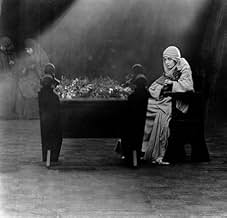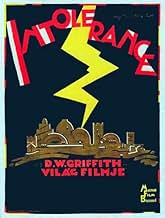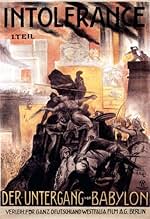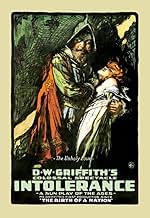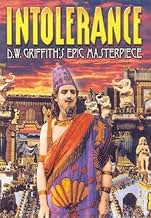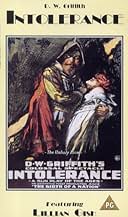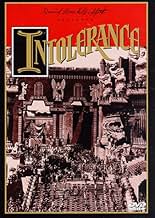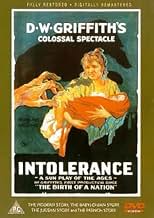IMDb रेटिंग
7.7/10
17 हज़ार
आपकी रेटिंग
एक गरीब युवती की कहानी, जो उसके पति और बच्चे से पूर्वाग्रह से अलग है, पूरे इतिहास से असहिष्णुता की कहानियों के साथ जुड़ी हुई है.एक गरीब युवती की कहानी, जो उसके पति और बच्चे से पूर्वाग्रह से अलग है, पूरे इतिहास से असहिष्णुता की कहानियों के साथ जुड़ी हुई है.एक गरीब युवती की कहानी, जो उसके पति और बच्चे से पूर्वाग्रह से अलग है, पूरे इतिहास से असहिष्णुता की कहानियों के साथ जुड़ी हुई है.
- पुरस्कार
- कुल 2 जीत
F.A. Turner
- The Dear One's Father
- (as Fred Turner)
Julia Mackley
- Uplifter
- (as Mrs. Arthur Mackley)
John P. McCarthy
- Prison Guard
- (as J.P. McCarthy)
कहानी
क्या आपको पता है
- ट्रिवियाDuring filming of the battle sequences, many of the extras got so into their characters that they caused real injury to one another. At the end of one shooting day, a total of 60 injuries were treated at the production's hospital tent.
- गूफ़One of the early title cards in the Judean sequence refers to Jesus having been from "the carpenter shop in Bethlehem". Though he was born in Bethlehem, he worked with his father in a carpenter shop in Nazareth, which is why he was known as Jesus of Nazareth.
- भाव
Intertitle: When women cease to attract men, they often turn to reform as a second option.
- क्रेज़ी क्रेडिटConstance Talmadge is credited as 'Georgia Pearce' for her performance as Marguerite de Valois in the French Story. She is credited under her own name in the role of The Mountain Girl in the Babylonian Story.
- इसके अलावा अन्य वर्जनThe movie was officially restored in 1989 by Kevin Brownlow and David Gill for Thames Television. It was transferred from the best available 35mm materials, color-tinted per D.W. Griffith's intent, and contains a digitally recorded orchestral score by Carl Davis. This 176-minute version was released on video worldwide, but has never been telecast in the U.S.
- कनेक्शनEdited into The Fall of Babylon (1919)
फीचर्ड रिव्यू
"Intolerance" is D.W. Griffith's apologia for "The Birth of a Nation" mostly in that it surpasses its predecessor's epic scale, thus replying to his critics. "The Birth of a Nation" was a racist film, and nothing in "Intolerance" proves otherwise, but I don't think that's the point, either. And, while Griffith calls his critics hypocrites, it's just as easy to call Griffith one for his racism. Yet, I have no disagreement that his films are art despite their messages. "Intolerance" contains much more agreeable views than "The Birth of a Nation", anyhow: Christian pacifism; support of labor; moderated progressivism; and condemnation of intolerance, hatred and inhumanity throughout the ages.
The narrative structure of "Intolerance" was revolutionary and particularly surprising for a filmmaker who had cemented in cinema a traditional and theatrical form of linear storytelling with his previous work. In "Home, Sweet Home" (1914), Griffith linked four separate stories with a single theme, but with each story told in full before proceeding to the next. With "Intolerance", he employed parallel editing, thus continually crosscutting between time, suspending plots and commenting on stories with other stories, and I think it's ingeniously congruent considering the stories are supposed to run parallel in their morals, or messages on the general theme of intolerance.
The four stories include a modern story, which features a fictional representation of the Ludlow massacre of strikers and a progressive era foundation of busybody reformers that indirectly causes the massacre and directly applies suffering on the central characters. It was originally intended as a complete film in itself and was later released as such under the title "The Mother and the Law". Then, there's the Babylonian story, which was also released by itself, as "The Fall of Babylon". It almost seems to be more likely to have been directed by Cecil B. DeMille than by D.W. Griffith, for all its sex and exotic set design against a historical setting. A contemporary of Griffith, however, DeMille had not yet figured out that formula and may well have been thinking of the Babylonian sequences in "Intolerance" when he did; one of his early pictures and first attempts at an epic, "Joan the Woman" (1917), does demonstrate Griffith's influence on him. Additionally, the sequence features the best performance in the film by ingénue Constance Talmadge as the "Mountain Girl". She, too, seems out of place in a Griffith production, with her sexuality, impropriety and independence. The lesser stories of Christ's life and his crucifixion and the events leading up to the St. Bartholomew's Day Massacre aren't especially interesting in themselves, as many have panned. Yet, I don't think that's essential, as they don't stand by themselves, but are part of a whole where they comment on and run parallel to each other and the other narratives.
The stories are connected by explanatory, as well as moralizing and poetical, intertitles and by glimpses of Lillian Gish endlessly rocking the cradle (taken from Walt Whitman). Reportedly, tinting also separated the stories upon initial release. Nearing the climax, however, these separations and transitions evaporate for an ever more merging and rapider plot. "Intolerance" is the apex of Griffith's innovations and developments in editing--the culmination of his achievements in "The Birth of a Nation" and his last-minute-rescue pictures and other Biograph shorts. Along the way, it was usually James and Rose Smith who aided him in the editing room. Doubtless, these achievements, especially in "Intolerance", greatly influenced the Soviet and European montage filmmakers, as well as subsequent filmmaking in general.
With the astounding success of "The Birth of a Nation", Griffith had the opportunity to make almost any film he wanted, and with "Intolerance" having cost nearly $400,000 to make, he did. (The some $100,000 budget for "The Birth of a Nation" had been unheard of in Hollywood.) The film's failure financially ruined Triangle Studios and considerably altered and limited Griffith's filmmaking career from thereon. As "The Birth of a Nation" demonstrated to Hollywood and the world how profitable and popular cinema could be, "Intolerance" told another important lesson on the risks and limitations involved.
Consuming much of the film's budget were Walter L. Hall's Babylon sets, and they are spectacular. They're also surprisingly imaginative and elaborate for D.W. Griffith, whose stagy, open-air sets in previous productions were generally unremarkable--besides those in "Judith of Bethulia" (1914), which pale in comparison. The influence of "Cabiria" (1914) is very evident, but where that film failed to equal the brilliance of its sets with the filming of them, "Intolerance" succeeds. The legendary crane shots are standouts.
Throughout the film, cinematographer "Billy" Bitzer masks the camera lens--more extensively than ever before--creating iris shots, a moving iris shot within a stationary shot and small-scale widescreen effects. Griffith and Bitzer are very much in control of the images, establishing us as spectators. The Babylonian scenes where characters look down at miniatures of the city, I think, also add to this emphasis. And, "Intolerance" is quite a spectacle, especially the Babylonian scenes. Overall, the cinematography, such as some extreme close-ups, is innovative and advanced. Additionally, Griffith and Bitzer once again proved themselves masters of filming battle scenes.
"Cabiria" and the other Italian epics were a great impetus for Griffith to have embarked on his own two epic masterpieces, but the Italian epics were merely super-theatrical, with "Cabiria" as its apex and somewhat of a bridge to Griffith making the epic a cinematic art and a cornerstone of the industry. Moreover, from his pioneering short films at Biograph, to the epics "The Birth of a Nation" and "Intolerance", and to a lesser extent, his work thereafter, nobody has had a greater influence on the course cinema would take than D.W. Griffith.
The narrative structure of "Intolerance" was revolutionary and particularly surprising for a filmmaker who had cemented in cinema a traditional and theatrical form of linear storytelling with his previous work. In "Home, Sweet Home" (1914), Griffith linked four separate stories with a single theme, but with each story told in full before proceeding to the next. With "Intolerance", he employed parallel editing, thus continually crosscutting between time, suspending plots and commenting on stories with other stories, and I think it's ingeniously congruent considering the stories are supposed to run parallel in their morals, or messages on the general theme of intolerance.
The four stories include a modern story, which features a fictional representation of the Ludlow massacre of strikers and a progressive era foundation of busybody reformers that indirectly causes the massacre and directly applies suffering on the central characters. It was originally intended as a complete film in itself and was later released as such under the title "The Mother and the Law". Then, there's the Babylonian story, which was also released by itself, as "The Fall of Babylon". It almost seems to be more likely to have been directed by Cecil B. DeMille than by D.W. Griffith, for all its sex and exotic set design against a historical setting. A contemporary of Griffith, however, DeMille had not yet figured out that formula and may well have been thinking of the Babylonian sequences in "Intolerance" when he did; one of his early pictures and first attempts at an epic, "Joan the Woman" (1917), does demonstrate Griffith's influence on him. Additionally, the sequence features the best performance in the film by ingénue Constance Talmadge as the "Mountain Girl". She, too, seems out of place in a Griffith production, with her sexuality, impropriety and independence. The lesser stories of Christ's life and his crucifixion and the events leading up to the St. Bartholomew's Day Massacre aren't especially interesting in themselves, as many have panned. Yet, I don't think that's essential, as they don't stand by themselves, but are part of a whole where they comment on and run parallel to each other and the other narratives.
The stories are connected by explanatory, as well as moralizing and poetical, intertitles and by glimpses of Lillian Gish endlessly rocking the cradle (taken from Walt Whitman). Reportedly, tinting also separated the stories upon initial release. Nearing the climax, however, these separations and transitions evaporate for an ever more merging and rapider plot. "Intolerance" is the apex of Griffith's innovations and developments in editing--the culmination of his achievements in "The Birth of a Nation" and his last-minute-rescue pictures and other Biograph shorts. Along the way, it was usually James and Rose Smith who aided him in the editing room. Doubtless, these achievements, especially in "Intolerance", greatly influenced the Soviet and European montage filmmakers, as well as subsequent filmmaking in general.
With the astounding success of "The Birth of a Nation", Griffith had the opportunity to make almost any film he wanted, and with "Intolerance" having cost nearly $400,000 to make, he did. (The some $100,000 budget for "The Birth of a Nation" had been unheard of in Hollywood.) The film's failure financially ruined Triangle Studios and considerably altered and limited Griffith's filmmaking career from thereon. As "The Birth of a Nation" demonstrated to Hollywood and the world how profitable and popular cinema could be, "Intolerance" told another important lesson on the risks and limitations involved.
Consuming much of the film's budget were Walter L. Hall's Babylon sets, and they are spectacular. They're also surprisingly imaginative and elaborate for D.W. Griffith, whose stagy, open-air sets in previous productions were generally unremarkable--besides those in "Judith of Bethulia" (1914), which pale in comparison. The influence of "Cabiria" (1914) is very evident, but where that film failed to equal the brilliance of its sets with the filming of them, "Intolerance" succeeds. The legendary crane shots are standouts.
Throughout the film, cinematographer "Billy" Bitzer masks the camera lens--more extensively than ever before--creating iris shots, a moving iris shot within a stationary shot and small-scale widescreen effects. Griffith and Bitzer are very much in control of the images, establishing us as spectators. The Babylonian scenes where characters look down at miniatures of the city, I think, also add to this emphasis. And, "Intolerance" is quite a spectacle, especially the Babylonian scenes. Overall, the cinematography, such as some extreme close-ups, is innovative and advanced. Additionally, Griffith and Bitzer once again proved themselves masters of filming battle scenes.
"Cabiria" and the other Italian epics were a great impetus for Griffith to have embarked on his own two epic masterpieces, but the Italian epics were merely super-theatrical, with "Cabiria" as its apex and somewhat of a bridge to Griffith making the epic a cinematic art and a cornerstone of the industry. Moreover, from his pioneering short films at Biograph, to the epics "The Birth of a Nation" and "Intolerance", and to a lesser extent, his work thereafter, nobody has had a greater influence on the course cinema would take than D.W. Griffith.
- Cineanalyst
- 18 अग॰ 2005
- परमालिंक
टॉप पसंद
रेटिंग देने के लिए साइन-इन करें और वैयक्तिकृत सुझावों के लिए वॉचलिस्ट करें
- How long is Intolerance?Alexa द्वारा संचालित
विवरण
बॉक्स ऑफ़िस
- बजट
- $3,85,907(अनुमानित)
- चलने की अवधि2 घंटे 43 मिनट
- ध्वनि मिश्रण
- पक्ष अनुपात
- 1.33 : 1
इस पेज में योगदान दें
किसी बदलाव का सुझाव दें या अनुपलब्ध कॉन्टेंट जोड़ें

टॉप गैप
By what name was Intolerance: Love's Struggle Throughout the Ages (1916) officially released in Canada in French?
जवाब

